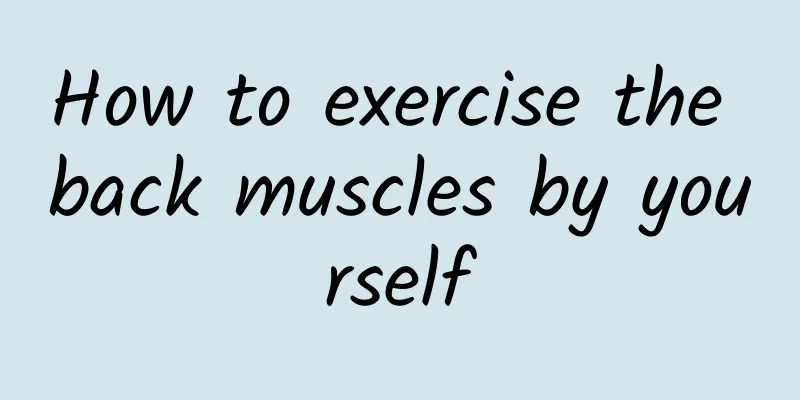How to exercise the back muscles by yourself

|
Many non-specific back pains can be relieved by exercising the back muscles. Back exercises can strengthen the back, abdomen and even lower limb muscles, thereby strengthening the stability of the spine, avoiding back injuries, and relieving pain. Here are some self-exercise methods for back muscles: 1. Supine lumbar press exercise The patient lies on his back with his hips and knees flexed. By contracting the abdominal muscles, he lowers his waist close to the bed. Hold for 10 seconds, repeat 20 times, 3 times a day. 2. Crunches Starting position: Bend your knees and do a crunch without moving your lumbar spine. While lying on your back, slide your hands down your lower back to support your lumbar spine. This position prevents your lumbar spine from pressing flat against the floor, reducing back pressure. Straighten one leg and bend the other. Place the foot of the bent leg on the ground, level with the knee of the straight leg. Action essentials: First tighten the abdominal muscles to prevent the body from moving, but do not cause pain. Lift the elbows off the ground and "hang" on both sides of the body, with both hands still under the waist. Keep the spine in a neutral position (including the neck), and then gently lift the head and shoulders off the ground. It is important to keep the neck (cervical spine) and the lower torso (lumbar spine) as still as possible. When practicing, only lift the head and shoulders off the ground, count to 10, and then return the back to the starting position. 3. Hip Bridge Lie on your back with your knees bent and your knees apart to the same width as your shoulders. Use your shoulders, back and feet as support and slowly lift your waist and hips until your waist and abdomen are level. Hold for a few seconds and then slowly lower. Do 20-30 reps each time, 1-2 times a day. 4. Five-point support Lie on your back, bend your knees, spread your knees shoulder-width apart, use your shoulders, elbows and feet as support points, slowly lift your waist and hips until your waist and abdomen are level, hold for a few seconds and then slowly lower. Do 20-30 times each time, 1-2 times a day. (This method is more recommended for patients with heavier weight or elderly patients, and the elderly can appropriately reduce the frequency and number of times) 5. Four-point support Use your hands and feet to support your body so that your head, back, and waist form an arch. The four-point support method is suitable for younger patients with better physical strength. 6. Three-point support Bend your elbows and place your upper limbs in front of your chest, using your head and feet as fulcrums. Straighten your chest and abdomen and do the bridge exercise. 7. Flying Swallow Lie prone, with your hands back, feet together, and waist strength to lift the head, chest and legs away from the wound, and continue for 2-3 seconds. Do 20-30 times each time, 1-2 times a day. 8. Side Bridge or Side Plank The side bridge exercise hits the major spinal stabilizers and is an exercise that integrates the quadratus lumborum and abdominal wall. Starting position: If you don't have enough strength or your abdominal wall can't be involved without pain, you can use your knees to support yourself. Lie on your side and use one elbow, hip, and the outside of your leg to support your body. How to do it: Use your left hand to support your left pelvis and push your hips up until your entire body is supported by your left elbow and knee. Your right hand can rest on your hip. Advanced methods include lifting your knees off the ground, using only your elbows and feet as support points, and changing the position of your arms to cross them forward to the opposite shoulder. 9. Bird Dog This exercise targets not only the lower back, but also the hip extensors. It also teaches you how to use the hips and shoulders correctly while keeping the spine stable. Using the "bird dog" exercise protects the spine from high pressure loads and ensures a stable pattern of muscle activity. It stimulates multiple, major back muscles in the thoracolumbar region (erector spinae, iliocostalis, and multifidus). Starting position: With four-point support, the spine is in the most resilient position, with slight flexion and extension. Through the movement, the lumbar spine is in the best pain-free position. The thoracic spine is slightly bent upward. The hips are flexed, and the knees touch the ground under the hips. Place your hands under the shoulders. Tighten the abdominal muscles appropriately, control the movement of the torso, and make sure that the movement occurs only in the hips and shoulders. Action essentials: Kneel with four-point support and raise the opposite arm and leg at the same time. The arm should not be higher than the shoulder, and the leg should not be higher than the hip. The goal is to make the limbs parallel to the ground and hold for 6 to 8 seconds. Kind tips: 1. When exercising, you should choose a method that suits you based on your actual situation. 2. Move slowly when exercising and don't use too much force. 3. Exercise in a gradual manner. If you experience worsening back pain or leg numbness during exercise, stop exercising immediately. If the pain does not improve after rest, please go to the hospital for treatment immediately. |
>>: National Nutrition Week | Nutritious recipes for three meals a day
Recommend
What should I do if vaginal itching recurs?
We know that once the patient has the problem of ...
What soup to cook during the first three months of pregnancy
In the early stages of pregnancy, pregnancy react...
Causes of cervical involutio
There are many possibilities. The most common rea...
Can fried peanuts still be eaten if they are mushy? What are the nutritional values of peanuts?
Peanuts are an excellent substitute for dairy and...
Factors affecting pituitary prolactinoma
I believe everyone must know the important role o...
What does abnormal STT mean?
What is the reason for abnormal ST segment in pre...
What are the symptoms when you are pregnant?
Every woman has different symptoms when she first...
What medicine is more effective for vulvar itching
If women have vulvar itching, they may feel restl...
Blood blisters on vulva
The vulva is the female external genitalia. It is...
The reason why the "face plate" has become bigger has been found! (It's not because of obesity)
In daily life, have you ever felt snapping or dis...
Why is vaginal discharge light green?
The normal color of female friends' leucorrhe...
The reason why leucorrhea is like tofu dregs and has no odor
Abnormal leucorrhea is a common gynecological dis...
What is metatarsalgia?
Recently, the editor has been suffering from meta...





![[Medical Q&A] Are cracks on the soles of feet caused by athlete’s foot?](/upload/images/67f0ff6f0ea4c.webp)



